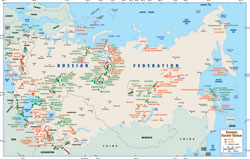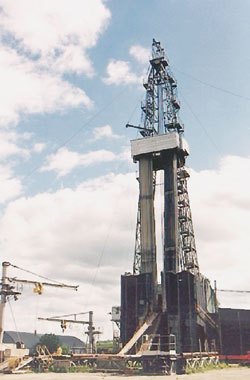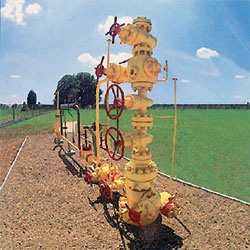FSU/Eastern Europe: Sustained growth is finally achieved
International Outlook: FSU/Eastern EuropeSustained growth is finally achievedProduction declines are a thing of the past, allowing the larger producers to consider how far their output can growAll countries by Sergei Rudnitsky and Alexander Rodionov, Russian Petroleum Investor, Moscow Russia. Gross Domestic Product (GDP) growth declined slightly in Russia during 2002, standing at 4.3%, compared to 5.0% in 2001. Exports (mainly oil) were the main GDP driver. In addition, high world oil prices produced a record 8.7% growth rate in Russia’s upstream sector. Exploration drilling totaled 2.51 million ft, down 39%. The 10 oil majors (LUKOIL, YUKOS, Surgutneftegaz, TNK, Sibneft, etc.) accounted for 94% of this amount. Surgutneftegaz led with 936,352 ft of exploratory hole. For the first time in a number of years, more oil reserves were added than those produced. New reserves stood at 380 million t (2.76 billion bbl), while production was 379 million t (2.755 billion bbl). Development drilling totaled 27.3 million ft, a 17% drop. Of this figure, 93% were drilled by the majors. Leading the pack was Surgutneftegaz with 8.5 million ft, or 31% of the total. There were 3,764 new oil wells commissioned last year, 19% less than in 2001. The majors accounted for 91% (3,410) of new oil wells. The number of new oil fields commissioned in 2002 was 28, with aggregate production of 3.74 million bbl. LUKOIL commissioned the largest number of new oil fields (14) with aggregate output of 1.38 million bbl.
Russian oil production averaged 7.56 million bpd, up 9% from 2001’s figure. The majors accounted for roughly 90% of output. At the end of 2002, producing oil wells in Russia numbered 118,232, a drop of 2% from the end of 2001. Majors operated 91% of these wells. LUKOIL was the leader, operating 22,808 oil producers. LUKOIL also remains the oil output leader (1.5 million bpd). LUKOIL’s growth is due to contributions from previously acquired production assets. Meanwhile, Tyumen Oil Co. (TNK) gained control of Sidanko during 2002. Accordingly, TNK transferred oil production assets to Sidanko. Other significant events during the 2002 – 2003 period were TNK and Sibneft’s $1.86-billion acquisition of a 74.95% stake in Slavneft (December 2002), and an agreement for YUKOS to buy 20% of Sibneft for $3 billion in cash (April 2003). The 2003 forecast envisages a 8% increase in oil production, up to 410 million t (8.17 million bpd). Growth leaders will be Sibneft (+25%) and YUKOS (+19%), exclusive of the Slavneft assets and YUKOS’s acquisition of Sibneft. For the first time in many years, the decline in gas production was reversed during 2002. Gas output climbed 2.4% to 595.3 Bcm (57.6 Bcfd), and Gazprom accounted for 88% of the total.
Kazakhstan. During 2002, Kazakhstan’s GDP rose 9.5%, said the government’s Statistics Agency. Kazakhstan’s oil and gas sector generated about 30% of national budget revenues in 2002. In addition, oil and gas production comprised 53.5% of the $7.7-billion total of all investments. In April 2002, KazMunaiGaz was set up as a national company that combined KazTransOil (oil transportation), KazTransGas (gas transportation) and Kazakhoil (E&P). Thus, all state oil and gas assets are concentrated under KazMunaiGaz’s control. The government continues to progress on petroleum legislation. Last January, President Nazarbaev signed a new “Law On Investments” that replaced two previous statutory acts. The Agip KCO-led consortium confirmed commercial reserves offshore at Kashagan field in July 2002. Recoverable reserves are 7 billion to 9 billion bbl. Last October, Agip KCO successfully completed its first exploration well on the Kalamas-more Block. The well initially tested 315 t/d of oil (2,290 bopd). PetroKazakhstan Kumkol Resources (formerly Hurricane Kumkol Munai) spudded four exploration wells at the North Nuraly structure in 2002, of which two were successful. The company will drill three other exploration/appraisal wells at that site during 2003. KazTransGaz drilled four exploration wells at Amangeldy gas field in Zhamylsk. Last December, KazTransGaz began drilling new production wells at Amangeldy field. This year, the firm plans 13 wells. Marketable gas deliveries from the field are set to begin during second-half 2003. Nationwide, drilling totaled 483 wells and 1.71 million ft of hole. Last year, Karachaganak Integrated Organization (KIO) made good progress in constructing the Karachaganak processing complex as part of Phase 2 development. In particular, a 120-MW, gas turbine, electric power station was built and commissioned. PetroKazakhstan Kumkol Resources drilled only 72 of 127 wells planned at Kyzylkia, Aryskum and Maibulak oil fields. The firm scaled back its drilling program, due to major difficulties associated with exports. Aktobemunaigaz (90% owned by CNPC) is spending $685 million to develop Kenkiyak and Zhanazhol fields. KazMunaiGaz conducted widespread workovers and enhanced recovery operations at its fields. These projects increased oil production by 720,000 t (14,340 bpd). During 2003, KazMunaiGaz will tap Kozhasai oil and gas/condensate field. Last year, 940,000 bopd were produced for an 18% gain. Production growth was achieved on the strength of large projects involving foreign companies, as KazMunaiGaz’s output share was less than 16%. While developing Karachaganak oil and gas/condensate field, KIO achieved record output, equaling 102,575 bpd of liquids and 169.5 Bcf, or 464 MMcfd. Tengizchevroil JV (TCO) produced 263,275 bopd, a 5.6% gain. Aktobemunaigaz raised its oil production 17% to 85,650 bpd. PetroKazakhstan Kumkol Resources produced 93,615 bopd in 2002, or 31% more than in 2001. Azerbaijan. During 2002, Azerbaijan’s GDP rose 10.6%, and industrial output grew 3.6%. Oil industry investment was 88%, or $1.5 billion, for an 85% increase. Growth was driven by start-up of the Phase 2 project, which involves full-scale development of Azeri, Chirag and Gyuneshli fields. Last year, SOCAR (State Oil Company of the Azerbaijan Republic) drilled an offshore exploration well at Gyurgyan-Deniz offshore field. The firm plans to drill three additional wells in this area. In July 2002, SOCAR drilled another well in the western part of shallow-water Gryazevaya Sopka (Muddy Hill) field that flowed crude. SOCAR specialists believe these resources could reach 9 million t (65.4 million bbl) of oil. AIOC completed pre-drilling of 12 wells at central Azeri field. Average well depth was 13,125 ft. Last year, China National Oil & Gas Exploration and Development Corp. (CNODC) and CNPC Hong Kong Ltd. (CNPCHK) acquired a 30% working interest to develop the Kyursangi-Karabagly Block, owned by the European Bank for Reconstruction and Development Caspian Drilling Co. (a JV formed by Global Santa Fe and SOCAR) drilled AIOC’s second well at Azeri field last year from the Dede Gorgud semi-submersible. This well will be followed by installation of the Azeri 1 offshore platform. Last February, SOCAR began drilling a fourth production well in the shallow-water area of Gyuneshli field, set to complete by mid-2003. SOCAR plans fast-track development of the field’s shallow-water portion. New wells completed from the GMSP-19 offshore platform will raise Gyuneshli’s gas production by nearly 90 MMcfd. Also in February, officials began construction under Phase 1 development of Shah/Deniz gas/condensate field. In 2002, oil output rose nearly 3%, to just over 305,000 bpd. Gas output dropped 7.3%, averaging 495 MMcfd. Turkmenistan. Gross industrial output grew 21.7% last year, including 10.1% improvement in oil and gas. Investment in the industry was $808 million, down 10.7%. Wildcat and appraisal drilling jumped 11.4%, to reach 292,323 ft. In 2003, exploration drilling is planned to total 409,120 ft. On Block 1 of the Turkmen shelf in the Caspian Sea, Malaysia’s Petronas Carigali achieved a daily oil flow of 14,100 bopd and 19 MMcfgd after drilling the fourth exploration well at Makhtumkuli field. Last October, Turkmen President Saparmurad Niyazov signed a PSA with Maersk Olie og Gas AS for offshore Blocks 11 and 12. Operators boosted development drilling 24%, to 589,239 ft. For 2003, they plan 577,423 ft. Including exploration activity, wells drilled totaled 75, up from 61 in 2001. This year, 79 wells are expected. In mid-2002, Ireland’s Dragon Oil completed its third production well offshore on the Cheleken Block, with a 2,900-bopd flowrate. A fourth production well was drilled on the block by the end of 2002, followed by a fifth well last April. Combined crude and condensate production averaged 194,207 bpd, a gain of 19.1%. Of this amount, 179,569 bopd were crude. Onshore output was 169,300 bopd. The main oil producer remains state concern Turkmenneft, accounting for 86.6% of total crude output. Last year, the firm produced 155,000 bopd (exclusive of 14,638 bcpd). At the end of 2002, state-owned Turkmenneft operated 2,397 oil wells capable of producing (up 0.8%), of which 2,013 wells were active (up 3.5%). At the end of 2002, the number of gas wells capable of producing was 969 (up 1.1%), of which 902 were active (up 7.2%). Gas production rose 4% last year, to 5.17 Bcfd. All gas output came from onshore fields. Uzbekistan. Data from the State Statistics Committee show that Uzbekistan’s GDP gained 4.2% in 2002. The official data differ from figures kept by the International Monetary Fund, which show GDP rising only 2.5%. Energy was 10% of the country’s exports. Development drilling has declined annually for the past five years, and 2002 saw a 3% drop to 262,795 ft. In February 2003, France’s Sofregaz won the second tender to develop Zevardy, Kutlak and Pamuk fields in Kashkadarinskaya at a cost of $90 million. Last February, Chinese firm Xinjiang International Industry Co. and state-owned Uzbekneftegaz jointly set up Boost International Economic and Technology Co., to operate enhanced recovery at Gazli gas field in northeastern Uzbekistan. Included is a $2.75-million workover program. Earlier this year, Dutch Chase Petroleum said it would form a joint venture with Uzbekneftegaz to develop two blocks in Buhara-Khiva. Potentially worth $200 million, the JV project is being reviewed by Uzbek officials. In first-half 2003, Uzbekistan acted to expedite the Kandym project, which includes participation from Russian major LUKOIL and gas company Itera. Production of oil and condensate decreased 1.3%, to 145,255 bpd. Decreased output was due to a progressive decline in productivity of the main producing fields. Uzbekneftegaz produced about 99% of all liquids. Uzbekneftegaz increased gas production 1.8% in 2002, to 5.65 Bcfd. Ukraine. The economy cooled down during 2002. GDP growth was 4.1%. The main reason for this was economic stagnation in two of Ukraine’s major trading partners, Russia and Germany. During 2002, state company Naftogaz Ukrainy contributed about 15% of total GDP and generated 18% of aggregate budget revenues. In 2002, drilling totaled 661,417 ft, and five oil and gas fields were discovered. Gas reserve additions were 830 Bcf, and 12.4 million bbl of oil reserves were added. Naftogaz Ukrainy conducted 82% of drilling and accounted for 78% of reserve additions. During 2002, Naftogaz Ukrainy began commercial output from East Kazantip gas field on the shelf of the Sea of Azov. North Bulganak field is slated for development, along with a field in the southern Sea of Azov. For the first time in 30 years, Ukraine achieved stability following a protracted decline in production volumes. Oil output averaged 73,696 bpd, virtually unchanged from 2001. Gas production was 1.82 Bcfd, up 3.4% from a year earlier. Naftogaz Ukrainy produced 97% of the oil and 95% of the gas. Georgia. Puma Energy in July 2002 signed an agreement with Indusmin Energy Corp. to jointly explore and develop tracts, particularly Block VIb in the center of the country. Meanwhile, CanArgo Energy won rights to Blocks XIg and XIh. Drilling fell by half, to two wells and 11,650 ft. Three wells are forecast this year. Oil production fell 34%, to 1,574 bpd. Gas output was 1.31 MMcfd. Other FSU republics. Very little has occurred in the remaining FSU countries. In Belarus, state firm Belarusnafta has estimated that oil reserves may last another 17 years, assuming that output does not exceed 40,000 bpd and no new deposits are found. Latvia last October repeated a previous licensing round of seven offshore blocks and attracted one bidder. In addition, authorities in Riga said in April that they will now permit onshore exploration. Finally, Gazprom is making a push into central Asia. The Russian gas giant signed exploration deals with Kyrgyzstan and Tajikistan. Eastern Europe (outside FSU). Polish Oil & Gas Co. (POGC) in May announced an oil find in western Poland. The firm estimated oil in place at 100 million to 150 million t. POGC officials acknowledged that, at an average 35% recovery rate, these figures translate to 250 million to 400 million bbl. Meanwhile, national output was 15,568 bopd (64% by POGC, 36% by Petrobaltic). FX Energy continued an aggressive acreage acquisition campaign. The company last winter won rights to 553,000 acres in the Permian basin.
In Hungary, Pogo Producing’s analysis continued during first-quarter 2003. Since mid-2002, the firm has reviewed seismic data compiled from a 140,000-acre 3D shoot, as well as 900 km of 2D work. The analysis is in advance of a drilling program. Hungarian Geological Survey predicts that drilling will remain at 30 wells, with a majority being exploratory. State firm MOL said that Hungarian oil output was down 8%. Gas production remained even at 316 MMcfd. Upstream activity in Yugoslavia (Serbia) has recovered slowly since the ouster of Slobodan Milosevic’s totalitarian regime nearly three years ago. Including suspended wells, drilling last year totaled 24 wells and 101,109 ft. For 2003, state company NIS-Naftagas told World Oil that it expects a small increase to 27 wells, of which 13 will be exploratory. Oil output averaged about 14,000 bpd. Slovenia’s drilling rate has picked up. Compared to pre-2001 levels of only one or two wells annually, there were five wells drilled in both 2001 and 2002. State firm Nafta Lendava expects this higher level to continue in 2003. National output remains minimal, at 33 bopd and 706,000 cfgd. Canada’s Loon Energy last February acquired a 35% interest in the Petisovsci and Dolina field areas. Romania’s National Agency for Mineral Resources (NAMR) announced the 37-block Fifth Licensing Round last February. The deadline for companies to submit bids is Sept. 15, 2003. Toreador Resources (100%) expanded its acreage, picking up the 324,000-acre Viperesti Block. Denver-based Galaxy Energy acquired Pannonian International and will develop the latter firm’s coalbed methane properties in the Jiu Valley. Tullow Oil last year completed a 557-km, 2-D seismic shoot. Data evaluation followed, and a decision on whether to drill the EPI-3 tract is due this year. Wintershall and Romgaz struck a gas find (6.3 MMcfd) in the Sighisoara 3 wildcat on the Transylvania South Block, and are reportedly developing the field. Romgaz also found gas (3.5 MMcfd) in the Valea Seaca East 1 well. Government officials said they will re-start privatization of Petrom, with plans to solicit bids by September. Albanian oil production rose 7%, to 6,361 bpd. Some of the rise came from new wells. Additional production was due to workovers. This year, state firm Albpetrol contracted Premier Oil, Preussag and IFC to work over 20 wells. Output should begin in September and could yield 3,550 bopd. Preussag farmed into Lundin Oil’s Blocks D and E. The firms will drill a wildcat on the South Tirana prospect this year. OMV was also due to spud a wildcat offshore. Drilling was relatively extensive, totaling 12 wells and 68,000 ft. The National Petroleum Agency predicts 14 wells for 2003. Crude output in Croatia appears to be stabilizing after steady declines in the 1990s and early 2000s. Output last year was down less than 2% from 2001’s level. Meanwhile, gas production was up again, gaining 3.6%. Italy’s ENI last year began development of the Ivana, Ika, Ida, Annamaria and Maica gas fields offshore. Combined, the fields hold 705 Bcf of gas. Firms involved in the Czech Republic’s Breclav Block were given a mid-2003 deadline by the Ministry of Environment to settle a dispute and forge a development plan for Postorna oil field. Geocan Energy, along with Carpathian Resources and Unigeo, had successfully challenged the transfer of the Breclav exploration license by estranged partner Czech Oil Co. (COC). Meanwhile, Carpathian Resources put Krásná oil field onstream in April 2003. Carpathian Resources is also a significant player in Slovakia, where the firm has explored the Klokocov license. Within the tract, the operator struck the Korna 1 light oil find, but testing revealed that the long-term flowrate would be too low to be economic. Carpathian is studying further prospects within the block. Activity within Bulgaria remains minimal. Last spring, an offshore well was drilled in search of gas, but it was dry. Including the dry hole, drilling totaled three wells for 30,840 ft. Oil output was 759 bpd, and gas production averaged 1.96 MMcfgd. |





